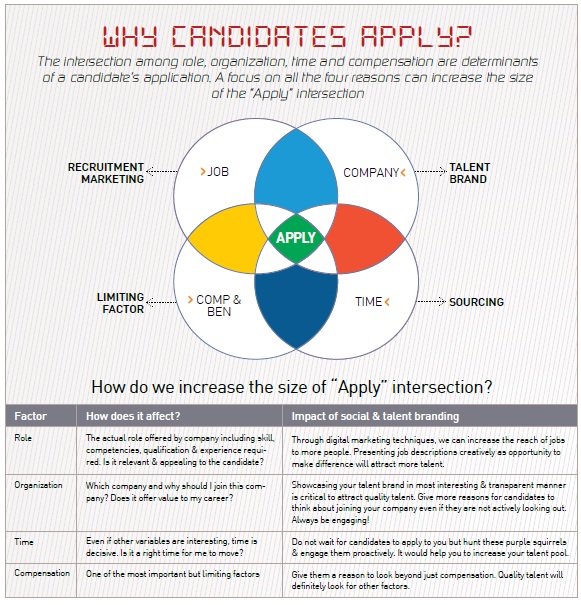4 Metrics to measure ROI for social and talent branding

Social & talent branding to Recruiting is what Marketing is to a sales organization
Organizations should consider social & talent branding as one of the key KPIs for its recruiters
Every recruiting trend report, HR event and HR leader today talks about digital disruption and employer branding for hiring. Finally, we are in the age where social is a norm and not a trend anymore. We are talking about “How” and not “Why” in most cases for social & employer branding. As this area becomes more mature, the grappling question for recruiting leaders is to understand the true impact on the grass-root level recruiting performance. Honestly, we still have grey area over here and a dire need to find answer to a golden question – “This all looks good but what’s the ROI”. Not too long ago I asked a similar question but failed to get any concrete response. I continued my search for the right answer through discussions with stakeholders, industry experts including ups and downs which I faced during the journey. This may seem like the Da Vinci Code but TA teams need to understand & simplify the answer to push social & branding agenda more convincingly. This is my attempt to find some answers for this.
I remember my first interaction with social media probably 10 years ago in terms of recruiting and it was nothing more than a channel which provided us more candidates than job portals. As digital disruption started to become impactful, social became an opportunity for recruiting leaders to expand the talent reach. If you really think, social & talent branding to Recruiting is what Marketing is to a sales organization. However, in lot of cases –social talent branding gets tagged as a “high-cost” item or even if it’s being spent – every dime needs to showcase a “tangible” ROI. In most of cases, ROI means number of hires and ultimately social media is considered as a channel. This is where we either devalue the talent branding or look at it with very narrow lenses.
Candidate Journey in digital age
Just like marketing, candidate today consumes information about any brand from multiple channels. Candidate may start his/her journey into company profiling from social through Facebook Careers pages and may get more interested to look at the company’s careers portal. At this point, the candidate is noticing, considering and getting influenced by talent brand. This can further initiate word of mouth conversations, asking references, going to Glassdoor etc. Good candidates will try to find every bit of info about company before applying and interviewing. Once they are ready to apply – they can chose any entry point including social, LinkedIn, job portals, referrals, careers site, third party vendors etc. Applying through any of these channels in most of the cases is the outcome of the influence/talent branding. However, what we end up measuring is only “How did they apply” and not “Why did they apply”. Looking at social just as another channel may be easier & convenient way to measure but surely not the most effective. It’s important to measure the “Why” effect and variables around it.

Focusing on the “Why” Factor
In my view, candidates apply to any job for majority of four different reasons. The intersection of these four reasons in most cases result in actual “Apply” process for a candidate. As a strategic recruiting driver, companies need to invest in expanding these reasons and create more intersection points to attract talent.
What’s wrong with measuring ROI as just number of hires?
Let’s take a step back and think about the objectives with social recruiting & talent branding. Are they purely tactical in terms of “more hires”? Have you considered the effects on influence, engaging & branding. With existing brand – you are only able to attract, offer & convert limited talent pool; adding social into this formula will not give you more hires automatically. Even if you attract more talent by posting more sponsored job ads, they may apply but why should they join you? This is not just“broadcasting” medium but use it strategically to provide more reasons for candidates to engage in your career offering conversations. In order to get more hires, you need to create larger pipeline and thus creating a larger impact on untapped audience to generate bigger funnel.
Hiring is a consequence of the way you brand, attract & engage candidates. Problem with current formula of number of hires is thus obvious! We are only looking at the output but not input. Social & talent branding helps you to build a stronger input into your funnel and thus you need to invest to build follower community and target audience who appreciate your “talent brand”.
This all looks good but what’s the real ROI?
The “tangible” outcome of hiring is just the tip of the iceberg. It will never improve unless we look at larger iceberg beneath. Here are some metrics which we need to measure to understand the impact of social & talent branding:
Metric #1: Engaged Followers
This metric can be further broken down in the following metrices:
- How many “engaged” followers & fans you have on social media?
- What is the strength of your talent community beyond social media pages?
- Number of views of your employee profiles on LinkedIn – shows you strength of their network
- What percentage of interested followers do you hire?
- What percentage of interested followers do you end up losing to your competitors? (Opportunity loss)
- Do you see more response to your emails/calls from followers than non-followers?
Metric #2: Quality of Hire & Talent Brand Index
This metric can be further broken down in the following metrices:
- Have you analyzed if the talent which you hire with impact from social media tends to:
- Stay longer than others?
- Receive higher rating in performance management?
- Impact on careers page:
- Have you seen an increase in hits on careers page?
- Have you seen more hires coming from your Careers page?
- Cost savings due to increase in organic hiring through careers page.
- Percentage of increase in talent brand index (TBI) OR any similar measurement
Metric #3: Talent Pool
This metric can be further broken down in the following metrices:
- Have you seen an increase in the overall applications to your company? What percentage?
- What are the effects on other channels like employee referrals, direct sourcing?
- Is there any positive effect on talent conversions?
- Application to hire
- Offer to hire
- Are you able to hire and recruit from your target companies more effectively than previously?
- What is the percentage of cost reduction due to decrease in cost for external portals & 3rd party agencies?
- Have you seen a decrease in the time to hire for certain skills because you are engaging a larger talent pool?
Metric #4: Candidate experience
This metric can be further broken down in the following metrices:
- More careers page hits
- Less bounce-off rates on the careers page
- Less time to apply due to social hire plugins
- Better candidate experience in surveys
In summary, most of the above ROI parameters directly/indirectly affect the decision & experience of candidates to join the company. Thus, it’s important to focus on these parameters as an input rather than only looking at output factor. Most importantly, you should definitely consider social & talent branding as one of the key KPIs for your recruiters as the success depends on their adoption. It is a journey of the recruiter to understandthe marketing & technology space closer to get benefitted from the transformation.
So, next time someone asks about ROI of employer branding & social – please discuss beyond the obvious and go deeper to make impact where it matters most. That’s where the real disruption happens!












